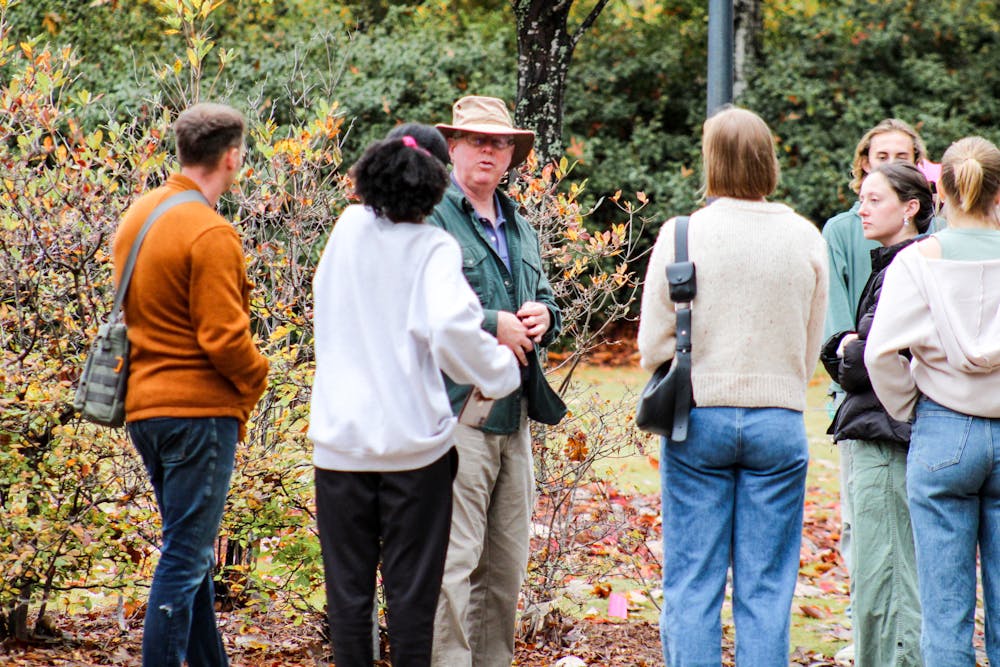On Nov. 10 and 11, the Permaculture Tigers, a student organization focused on promoting sensible land management, held meetings throughout campus to plan for a sensory garden.
The Permaculture Tigers, working with the university's Office of Sustainability, hosted two guest speakers: Alan Booker and Chase Jones. These expert permaculture designers helped guide students on how to cultivate a sensory garden, which would be the campus' first if implemented.
The event started on Friday, Nov. 10, running from 1 to 5 p.m., and resumed Saturday, Nov. 11, at 9 a.m. and ended at 4 p.m. At least 20 students throughout the event’s progression were in attendance and eager to learn and share their ideas.
On Friday, club executives and the guest speakers spoke to students about sensory gardens and how they are different from regular gardens.
According to Breck Bowen, alumni advisor for the Permaculture Tigers, permaculture is “a land stewardship technique that borrows from natural cycles and indigenous practices to do a kind of holistic land maintenance.”
“Through [permaculture], you are able to create a sense of permanent culture,” Bowen said. “So, you’re looking at space as it exists, but you’re trying to make sure that it is designed to last and be sustainable and have a positive impact on future generations.”
Bowen explained that sensory gardens are designed to engage visitors' senses of sight, smell, hearing, taste and touch and promote "nervous system relaxation."
"A lot of mental health grounding techniques involve the senses," Bowen said. "Having a kind of held space that shields you from the outside world makes people feel grounded when they are in a stressful environment.”
Bowen helped start the Auburn Refuge Project in 2021, which inspired ideas of a sensory garden for Auburn’s campus. The Auburn Refuge Project was aimed at reimagining the campus’ lawn space to reduce the ecological footprint.
So far, the Permaculture Tigers have conducted surveys among students to see if the sensory garden was something desired, and now with this past weekend’s design charrette workshop, they hope to see more students express interest in the project. The workshop brought together many interested parties from across campus who will work on implementing the garden.
On Friday, students were instructed to follow the permaculture designers around campus to analyze green spaces and explain the pros and cons of each space from a permaculturist’s perspective.
Attendees agreed that a lawn space west of Cater Lawn was the best place based on sound level, seclusion, nature’s presence, sun exposure and its centrality on campus. Sensory garden placement is chosen with peace and privacy in mind, as well as the presence of organisms and plants already present in the environment.
This design charrette not only expressed the organization’s plan but also invited many academic departments on campus to the event to discuss logistics and what it would take to make this garden happen.
Mike Kensler, director of the Office of Sustainability, noted the garden’s need for low-maintenance upkeep and, of course, that it is very sustainable. He said that signage for edible plants and nontoxic plants were a must.
Auburn University Facilities Management said the garden should be low maintenance, due to various resource concerns such as training and water use.They also expressed safety concerns since it is on a slight slope. Both Facilities Management and the Office of Sustainability were firm needing on universal accessibility for the space.
On Saturday, the hard work began. Students worked closely with Booker and Jones to create landscape maps and decide what to place in the garden. Students throughout the event were engaged and learning the fundamentals of immersing themselves and how to design this garden with sustainability in mind.
Most were happy to share their ideas and suggestions on the garden and what they thought other students on campus would like to see in the space. Suggestions for bird feeders, various seating spaces, shade, bog plants and edible and medicinal vegetation were made.
The Irritable Bao, a local restaurant, catered lunch on Saturday. The Office of Sustainability provided participants with reusable plates, utensils and sticks they could take home.
Students were then taught how to select plants based on plant and organism relationships as well as a plant’s tolerance to Auburn’s climate. Booker and Chase explained how to take care of the garden over time. They also noted the need for diligent research and keeping biophilic and trauma design in mind when creating the final layout.
The permaculture designers showed students what to look for when creating a sensory garden, such as plants that would stimulate each of the senses in a sensory garden. They also recommended resources and softwares that could be used to analyze sun exposure and plant relationships.
“We’ve been in the process of trying to implement [the garden's] creation on campus, so we are just trying to get as many students on board with it," said Ashley Spencer, junior in environmental sciences and secretary of the Permaculture Tigers.
Jones, co-founder of Biodesic Strategies and a former student of Booker, expressed the need find creative ways to involve the student body with the project. Booker, alumnus of the university and founder and executive director of the Institute of Integrated Regenerative Design, agreed.
“Permaculture is very transdisciplinary by its nature,” Booker said. “It’s the idea that permaculture is well past just agriculture and horticulture. I’ve used permaculture design in patterning cities and transportation networks.”
Both stated that the club’s biggest obstacle will be meeting the criteria of each university department and gaining enough support from students and faculty to get the garden started. It is still undecided when the university plans to break ground for the garden.
Do you like this story? The Plainsman doesn't accept money from tuition or student fees, and we don't charge a subscription fee. But you can donate to support The Plainsman.





